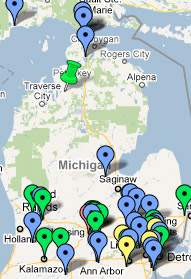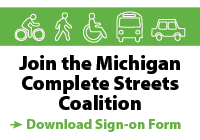You are currently browsing the tag archive for the ‘Pedestrian crossing’ tag.
This post continues an ongoing blog series highlighting various complete street elements, their benefits, and use in Michigan communities. Check back often to catch future posts, and keep a lookout for pedestrian hybrid beacons in your community!
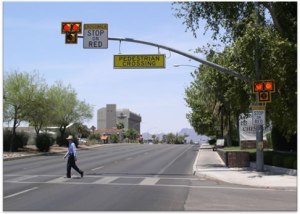 What are Pedestrian Hybrid Beacons? Also known as HAWK Signals (High Intensity Activated Crosswalk signals), pedestrian hybrid beacons are traffic devices used to assist pedestrians crossing busy streets. When a pedestrian activates the system by pressing a button, overhead flashing yellow lights alert drivers that pedestrians have activated the signal. The yellow light then turns solid, preparing drivers to make a complete stop at the intersection. When the light turns red, pedestrians receive a white “walk” signal, and may proceed across the intersection. A flashing red appears when the pedestrian countdown starts, telling the driver that if the intersection is clear, he or she may proceed through it with caution. When the pedestrian countdown has expired, the beacon goes dark and traffic continues on its way.
What are Pedestrian Hybrid Beacons? Also known as HAWK Signals (High Intensity Activated Crosswalk signals), pedestrian hybrid beacons are traffic devices used to assist pedestrians crossing busy streets. When a pedestrian activates the system by pressing a button, overhead flashing yellow lights alert drivers that pedestrians have activated the signal. The yellow light then turns solid, preparing drivers to make a complete stop at the intersection. When the light turns red, pedestrians receive a white “walk” signal, and may proceed across the intersection. A flashing red appears when the pedestrian countdown starts, telling the driver that if the intersection is clear, he or she may proceed through it with caution. When the pedestrian countdown has expired, the beacon goes dark and traffic continues on its way.
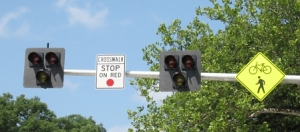 Pedestrian hybrid beacons have overhead crosswalk signs to further alert drivers to the pedestrian crossing. For the full breakdown of the sequence with pictures, see the City of Ann Arbor’s guidance. Because these signals can be confusing to new users, extensive education campaigns should run in tandem with the installation.
Pedestrian hybrid beacons have overhead crosswalk signs to further alert drivers to the pedestrian crossing. For the full breakdown of the sequence with pictures, see the City of Ann Arbor’s guidance. Because these signals can be confusing to new users, extensive education campaigns should run in tandem with the installation.
Why Use Pedestrian Hybrid Beacons? Pedestrian hybrid beacons provide pedestrians a safer crossing alternative than traditional crosswalks, especially in mid-block locations that are heavily travelled by pedestrians. Because the devices are only activated when a pedestrian is present, drivers experience minimal delays.
When to Use Pedestrian Hybrid Beacons: Pedestrian hybrid beacons became an approved traffic device in the Federal Highway Administration’s (FHWA) Manual on Uniform Traffic Control Devices (MUTCD) in 2009. The manual states that pedestrian hybrid beacons must be installed at marked crosswalks. Whether the devices are appropriate for a particular intersection primarily depends on traffic volumes and pedestrian counts (the MUTCD provides a sliding scale for high-speed roadways and low-speed roadways). Pedestrian walking speeds, posted vehicle speed limits, pedestrian delay time, and street widths are considered as well. The MUTCD recommends the following placement requirements for pedestrian hybrid beacons:
- The pedestrian hybrid beacon should be installed at least 100 feet from side streets or driveways that are controlled by STOP or YIELD signs,
- Parking and other sight obstructions should be prohibited for at least 100 feet in advance of and at least 20 feet beyond the marked crosswalk, or site accommodations should be made through curb extensions or other techniques to provide adequate sight distance,
- The installation should include suitable standard signs and pavement markings.
In practice, pedestrian hybrid beacons are often located at minor street intersections that are controlled by stop signs, opposite of the MUTCD’s guidance (A FHWA safety study consisted of 21 pedestrian hybrid beacons at minor street intersections). Transit and school locations are excellent candidates for these devices.
Safety Benefits: Data suggest that pedestrian hybrid beacons are effective safety devices for pedestrians when coupled with enforcement and education campaigns. A 2010 FHWA before-and-after study found that pedestrian hybrid beacons led to a 29% reduction in total crashes, a 69% reduction in pedestrian crashes, and a 15% reduction in severe crashes. The District of Columbia Department of Transportation found an average pedestrian hybrid beacon compliance rate of 97.1%, showing that drivers are much more likely to stop for pedestrians wishing to cross the street at crosswalks equipped with the devices. Where pedestrian hybrid beacons are placed at mid-block locations, safety gains are particularly notable: up to 70% of pedestrian fatalities occur at mid-block locations, where drivers travel at higher speeds and are less likely to be cognizant of pedestrians. Michigan communities considering installing a pedestrian hybrid beacons should note that education and enforcement efforts at the time of the installation play a key role in safety gains.
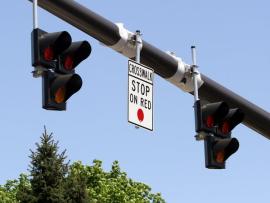 What Drivers Should Know: Pedestrian hybrid beacons are only activated when pedestrians wishing to cross a street activates the signal. If the lights of the beacon are dark, vehicles can proceed through the crosswalk. Flashing yellow lights usually last around three seconds, during which the driver should prepare to stop. A solid yellow light indicates the driver must stop. Once the light turns red, pedestrians will cross. Flashing red lights indicate that if there are no pedestrians in the walk, the driver may proceed through the walk with caution. After the flashing red lights, the signal will go dark again, and vehicles may freely pass through the intersection again.
What Drivers Should Know: Pedestrian hybrid beacons are only activated when pedestrians wishing to cross a street activates the signal. If the lights of the beacon are dark, vehicles can proceed through the crosswalk. Flashing yellow lights usually last around three seconds, during which the driver should prepare to stop. A solid yellow light indicates the driver must stop. Once the light turns red, pedestrians will cross. Flashing red lights indicate that if there are no pedestrians in the walk, the driver may proceed through the walk with caution. After the flashing red lights, the signal will go dark again, and vehicles may freely pass through the intersection again.
Cost Considerations: Pedestrian hybrid beacons are more expensive than traditional crosswalks, but remain an attractive option due to safety benefits. The average beacon costs from around $75,000 to $150,000, with signals suspended by span wire being less expensive, and signals attached to a mast arm being more expensive. Costs also vary depending on the characteristics of the particular location, road speeds, engineering constraints, and other factors.
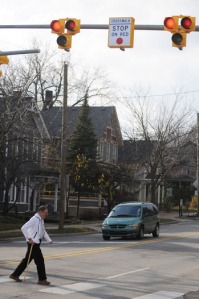 Pedestrian hybrid beacons are showing up in Michigan as more communities become aware of the technology and safety benefits are realized. The Michigan Department of Transportation (MDOT) installed the first pedestrian hybrid beacon on a state trunkline in 2010 in downtown Ann Arbor. MDOT has since installed a pedestrian hybrid beacon on US 12 BR (Michigan Ave) in Ypsilanti, and The City of Ypsilanti recently set forth plans to construct one on Michigan Avenue along the Border-To-Border Trail. Wayne State University has also installed a pedestrian hybrid beacon along Anthony Wayne Drive to help make pedestrian travel safer.
Pedestrian hybrid beacons are showing up in Michigan as more communities become aware of the technology and safety benefits are realized. The Michigan Department of Transportation (MDOT) installed the first pedestrian hybrid beacon on a state trunkline in 2010 in downtown Ann Arbor. MDOT has since installed a pedestrian hybrid beacon on US 12 BR (Michigan Ave) in Ypsilanti, and The City of Ypsilanti recently set forth plans to construct one on Michigan Avenue along the Border-To-Border Trail. Wayne State University has also installed a pedestrian hybrid beacon along Anthony Wayne Drive to help make pedestrian travel safer.
Have a pedestrian hybrid beacon in your community? Let us know.
UPDATE:
We were recently notified by the City of Dearborn that it has installed a HAWK signal on Evergreen Road, which connects the University of Michigan-Dearborn’s main campus to the new student housing development (across Evergreen). The signal was completed in August 2013 with plans to extend the non-motorized trail through the Fairlane Town Center roads. The signal was a critical piece for the connection which extends the existing Rouge River Gateway Trail (21+ mile trail) into Dearborn’s urban city fabric.
Check out these resources for more information:
Driver View and Pedestrian View of Pedestrian hybrid Beacon Operations
FHWA Proven Safety Measures: Pedestrian Hybrid Beacon
Next Topic: Contra-Flow Bike Lanes Explained
Previous Topic: Sharrows Explained



